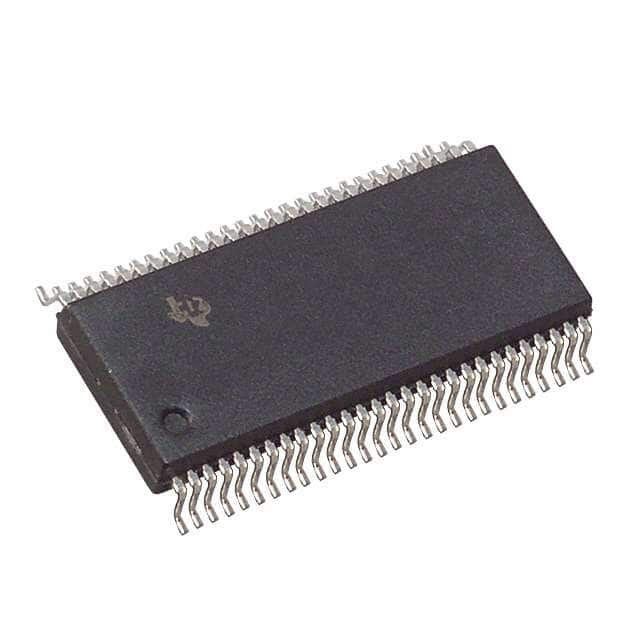Viz Specifikace pro podrobnosti o produktu.

SN74LVT16501DLR
Product Overview
- Category: Integrated Circuit (IC)
- Use: Data Bus Transceiver
- Characteristics:
- High-speed operation
- Low power consumption
- Wide voltage range
- 3-state outputs
- Package: 56-pin SSOP (Shrink Small Outline Package)
- Essence: Bidirectional transceiver for data bus communication
- Packaging/Quantity: Tape and Reel, 2500 units per reel
Specifications
- Supply Voltage Range: 2.7V to 3.6V
- Input Voltage Range: 0V to VCC
- Output Voltage Range: 0V to VCC
- Operating Temperature Range: -40°C to +85°C
- Maximum Propagation Delay: 5.8ns
- Maximum Operating Frequency: 200MHz
Detailed Pin Configuration
The SN74LVT16501DLR has a total of 56 pins, which are divided into four groups:
Group A (Pins 1-14):
- Inputs (A1-A14)
- Outputs (B1-B14)
Group B (Pins 15-28):
- Inputs (C1-C14)
- Outputs (D1-D14)
Group C (Pins 29-42):
- Inputs (G1-G14)
- Outputs (H1-H14)
Group D (Pins 43-56):
- Inputs (J1-J14)
- Outputs (K1-K14)
Functional Features
- Bidirectional data transfer between two independent buses
- 3-state outputs allow multiple devices to share the same bus
- Non-inverting outputs for minimal signal distortion
- High-speed operation enables efficient data transmission
- Low power consumption for energy-efficient applications
- Wide voltage range allows compatibility with various systems
Advantages and Disadvantages
Advantages: - High-speed operation facilitates fast data transfer - Low power consumption reduces energy usage - Wide voltage range ensures compatibility with different systems - 3-state outputs enable bus sharing among multiple devices
Disadvantages: - Limited number of input/output pins (14 per group) - May require additional components for specific applications
Working Principles
The SN74LVT16501DLR is a bidirectional transceiver that enables data transfer between two independent buses. It operates by receiving data from one bus and transmitting it to the other, or vice versa. The 3-state outputs allow the device to be disconnected from the bus when not in use, enabling multiple devices to share the same bus without interference.
Detailed Application Field Plans
The SN74LVT16501DLR is commonly used in various applications, including:
- Data communication systems: Enables efficient data transfer between different subsystems or modules.
- Microprocessor interfacing: Facilitates communication between microprocessors and peripheral devices.
- Industrial automation: Used in control systems to exchange data between different components.
- Automotive electronics: Enables data transmission in automotive systems, such as engine control units and infotainment systems.
- Networking equipment: Used in routers, switches, and network interface cards for data transfer between network components.
Detailed and Complete Alternative Models
- SN74LVC16501ADLR: Similar functionality with improved voltage tolerance.
- SN74LVTH16501DLR: Higher speed operation with slightly increased power consumption.
- SN74LVCH16501ADLR: Lower power consumption with reduced operating frequency.
These alternative models offer similar features and can be considered based on specific application requirements.
Word count: 408 words
Seznam 10 běžných otázek a odpovědí souvisejících s aplikací SN74LVT16501DLR v technických řešeních
Sure! Here are 10 common questions and answers related to the application of SN74LVT16501DLR in technical solutions:
Q: What is SN74LVT16501DLR? A: SN74LVT16501DLR is a 16-bit universal bus transceiver with 3-state outputs, designed for asynchronous communication between data buses.
Q: What is the operating voltage range of SN74LVT16501DLR? A: The operating voltage range of SN74LVT16501DLR is typically between 2.7V and 3.6V.
Q: What is the maximum data transfer rate supported by SN74LVT16501DLR? A: SN74LVT16501DLR supports a maximum data transfer rate of up to 200 MHz.
Q: Can SN74LVT16501DLR be used as a level shifter? A: Yes, SN74LVT16501DLR can be used as a level shifter to convert signals between different voltage levels.
Q: How many input/output pins does SN74LVT16501DLR have? A: SN74LVT16501DLR has a total of 48 pins, with 16 inputs, 16 outputs, and additional control pins.
Q: Is SN74LVT16501DLR compatible with both TTL and CMOS logic levels? A: Yes, SN74LVT16501DLR is compatible with both TTL and CMOS logic levels, making it versatile for various applications.
Q: Can SN74LVT16501DLR be used in bidirectional data transmission? A: Yes, SN74LVT16501DLR supports bidirectional data transmission, allowing data to be sent and received on the same bus.
Q: What is the typical propagation delay of SN74LVT16501DLR? A: The typical propagation delay of SN74LVT16501DLR is around 4.5 ns.
Q: Does SN74LVT16501DLR have built-in ESD protection? A: Yes, SN74LVT16501DLR has built-in ESD protection, ensuring robustness against electrostatic discharge.
Q: Can SN74LVT16501DLR be used in high-speed data communication applications? A: Yes, SN74LVT16501DLR is suitable for high-speed data communication applications, thanks to its fast switching speed and low power consumption.
Please note that these answers are general and may vary depending on specific application requirements and datasheet specifications.

